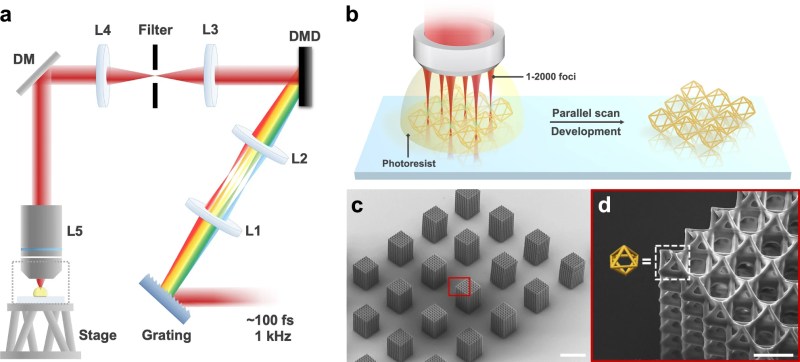3D printing by painting with light beams on a vat of liquid plastic was once the stuff of science fiction, but now is very much science-fact. More than that, it’s consumer-level technology that we’re almost at the point of being blasé about. Scientists and engineers the world over have been quietly beavering away in their labs on the new hotness, nanoscale 3D printing with varying success. Recently IEESpectrum reports some promising work using holographic imaging to generate nanoscale structures at record speed.
Current stereolithography printers make use of UV laser scanned over the bottom of a vat of UV-sensitive liquid photopolymer resin, which is chemically tweaked to make it sensitive to the UV frequency photons. This is all fine, but as we know, this method is slow and can be of limited resolution, and has been largely superseded by LCD technology. Recent research has focussed on two-photon lithography, which uses a resin that is largely transparent to the wavelength of light concerned, but critically, can be polymerized with enough energy density (i.e. the method requires multiple photons to be simultaneously absorbed.) This is achieved by using pulsed-mode lasers to focus to a very tight point, giving the required huge energy density. This tight focus, plus the ability to pass the beam through the vat of liquid allows much tighter image resolution. But it is slow, painfully slow.
photopolymer resin, which is chemically tweaked to make it sensitive to the UV frequency photons. This is all fine, but as we know, this method is slow and can be of limited resolution, and has been largely superseded by LCD technology. Recent research has focussed on two-photon lithography, which uses a resin that is largely transparent to the wavelength of light concerned, but critically, can be polymerized with enough energy density (i.e. the method requires multiple photons to be simultaneously absorbed.) This is achieved by using pulsed-mode lasers to focus to a very tight point, giving the required huge energy density. This tight focus, plus the ability to pass the beam through the vat of liquid allows much tighter image resolution. But it is slow, painfully slow.
The latest idea, from a team of researchers from The Chinese University of Hong King, and a couple of related parties, is to use a DLP micromirror array to produce a holographic image, essentially a thousand tightly focussed and controllable beams all operating in a parallel. And, where there is parallelism, there is an increase in speed. Reported test prints in the special dual-photon resins were produced at up to 54 mm^3 per hour with a maximum 90 um resolution, though likely not at the same time. Some additional interesting results were shown, using a suspension of Iron Oxide nanoparticles, the technique produced micromachines that could be magnetically manipulated. Additionally, by controlling the individual beam powers as the print progressed, up to eleven grey-scale values could be generated, allowing variable material properties to be realized.
Holograms are fun, so here’s a quick one about DIYing some for your own amusement. Once you’ve dispatched that, do checkout this post about a project utilizing tensorflow to predict what a hologram would look like from only 2D data courtesy of an off-the-shelf camera.
















Resin as expensive as perfume.
3dresyns produces a number of 2ppResin formulations in the $1.4-2/g range.
now a cheap femtosecond laser….HA!
Normal laser were laboratory exclusive hightech when invented, and expensive. Now you can get cheap laser pointers.
If there is mass market demand, it could become reasonable affordable.
Very cool. It looks like it could be useful for constructing micro-machinery that could mass produce parts in a micro-factory of sorts that required absurd precision for non-lithographic construction. Lasers are great for this kind of work but they are costly. However, if you can use a costly laser to cheaply make micro-machines that can do the same work then you have a winning proposition. I’m not saying micro-sized plastic machines, I’m saying this could be a useful step in the construction process.
Sounds interesting, maybe could be used for eye-surgery as well, with very targeted and limited range laser application.
Think you meant 90nm, not um!